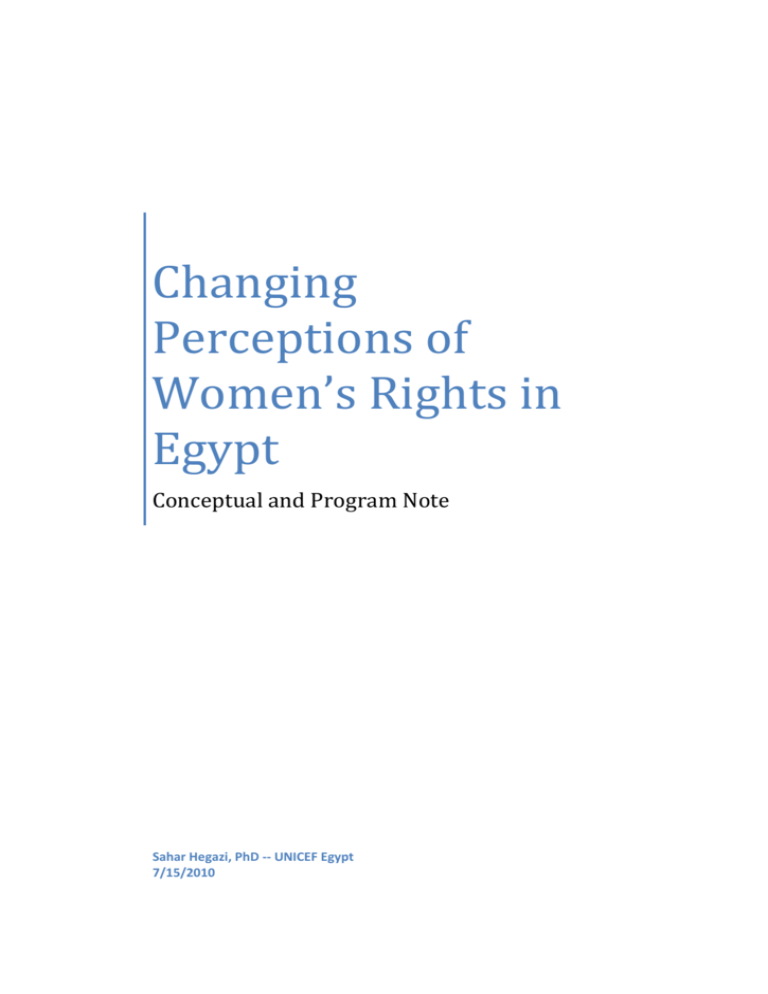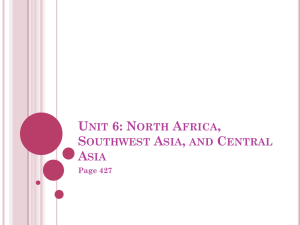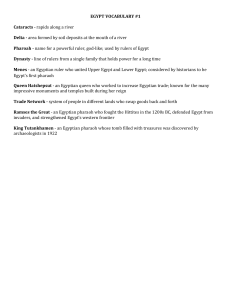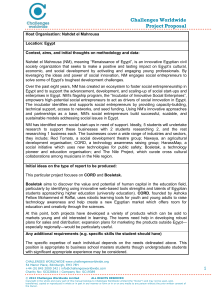Changing Perceptions of Women*s Rights in Egypt
advertisement

Changing Perceptions of Women’s Rights in Egypt Conceptual and Program Note Sahar Hegazi, PhD -- UNICEF Egypt 7/15/2010 I. INTRODUCTION1 A. Overview of Gender Rights in Egypt The Egyptian constitution provides its citizens absolute, unconditional equality regardless of sex, creed, origin, or ethnicity (Annex 4, Article 40). Yet the degree of gender discrimination is considered to be medium to high in Egypt according to the Social Institutions and Gender Index (SIGI), which was developed by the OECD Development Centre in cooperation with Göttingen University (Atlas of Gender and Development, How Social Norms Affect Gender Equality in Non OECD Countries, 2010). According to the same report, within the Middle East, Tunis comes on top of the least discriminatory countries compared to Yemen who was classified at the lowest end of the scale. Though notable progress has been made in Egypt on several fronts as far as social, political and / or economical status of women’s, social status remains to be quite dominated and controlled by strong religious and social systems that are not totally supportive of women attainment of their rights (CEDAW Committee Observation on Egypt’s 2009 Submitted Report.) The most recent observations made by the CEDAW committee on the recent combined reports of Egypt submitted in 2009 reflect the concern of lack of general awareness of women’s rights and the role of the social and cultural environment in impeding the fulfillment of these rights. A closer analysis of these observations highlight in a number of contexts, that the traditional and conservative social frameworks could be supporting the “persistent discrimination against and violations of the rights of women and girl child” (Morsy, 2010). The additional burden of poverty on women especially those who were are heading households coupled with the overall national high unemployment rates as well as the limited access to property rights such as lands and the limited participation in self employment-micro/small enterprise ownership complicates the situation further. Last but not least, the dominating culture of men being in “decision making positions” and the inequality between men and women in the sharing of power could be some of the underlaying causes for this low attainment of rights (Cairo Agenda for Action Situation Analysis, Unpublished Final Draft, 2010). However, we cannot take the analysis of women rights in isolation of the overall Egyptian social environment. The recent Human Development Report of Egypt published by UNDP as well as other National Human Rights Reports published by the Egyptian Human Rights Council have been consistently highlighting the need to improve the overall social environment where all the Egyptian citizens can enjoy his / her full rights on all levels and where embracing the rights of women, children, minorities and other groups becomes more possible to realize. 1 A complete summary is available in a power point form in annex 1 1 The immediate manifestation of the above situation is the negative stereotyping of the images of the women represented in the Women quota in the parliament Egyptian national media and the roles she plays and those she cannot do. The adjacent caricature gives an example of the subtle mocking of the idea of women quota as one example. Ohha dear....without adding extra chairs and baring the cost and the burden, surely any man would find his fellow PM standing would stand up and let her sit down out of courtesy” Needless to mention, that the perceived role of women in relation to the man as well as the rest of the society is not usually presented in a complete way. The continuous perpetuation of such negative images becomes of most concern when it is unconsciously or consciously done particularly by mass media. Given the powerful reach of Television for example, and its remarkable documented effect in framing the public mind and public agenda, serious attention is quite important to media performance. At no point however, such intervention can be considered sufficient to achieve the overall goal of improving the women’s and children attainment of their gender and social rights. However, interventions in this direction can become the catalyst to accelerate the achievement of the political and / or economical rights of women’s as well as other social issues of concern like violence and discrimination against women and children. B. Critical Analysis of Social Perception Of Women Rights In Egypt In Egypt, the strong prevalent cultural expectations that reinforce certain pre-determined roles both within and outside the family. The general traditional social frameworks have been to a great extent discouraging women’s participation in the political sphere and sometimes economic unless if the there is pressing economical needs. Combining professional ambition with their domestic roles is a double burden that men enjoy not worrying about. Generally, women conditions have improved on several fronts. The most recent quota for women in the parliament guaranteeing a minimum number of seats, giving the Egyptian nationality to children of Egyptian women born to non Egyptian fathers and the most recent family law allowing women to divorce their husbands unilaterally are some concrete positive steps on the way to achieving equality as Egyptian citizens. (CEDAW Committee Observation on Egypt’s 2009 Submitted Report, 2010). However, women status did not profoundly match these positive changes. In other words, these changes appear to be more like descriptive norms that the society is seeing and accepting without a further reconstruction of the supporting normative expectations. For example, women have been accepted to work (as a form of empirical expectation) yet they are not expected to do that without the approval of the husband or the brother (which is 2 the social norm). Failure to do that puts the woman under possible punishment and social pressure and which can lead to giving up her career. This in fact explains the earlier points made that women are not seen as active shareholders but more as recipients to be protected and / or controlled. Hence, the value of equality within the script of gender rights as members of the same society with equal rights and responsibilities is still not fully realized and accordingly, gender equity is an issue of concern on several fronts especially the political and economic fields. However, it is important to note that the situation varies according to several variables such as demographic, class, familial background…etc. However the prevailing norm that defines a woman is to be obedient, gives first priority to the man as the main provider of the household and for cultural and religions respect and which can be generalized in most of the cases. Similar, for the man, the prevailing norm that defines manhood is to be in control, powerful since he is considered the one in charge. For example, women in urban areas could enjoy more freedom and choices where the social network are less strict in enforcing social pressure on the members of the same network when compared with the rural areas. Practices associated with the described above norm range from domestic violence (verbal, physical, or moral), including gender-based violence against female candidates during the electoral process, sexual harassments in the streets, continuing underrepresentation of women in public, political and professional life and in reaching decision-making positions especially those as classified “sensitive or important” such as governors positions, senior judiciary system or a senior management in general. Most recently there has been a concern about educational attendance and attainment of both boys and girls. It has been documented that the percentage of girls who reach high school drop sharply after the middle schools and that boys’ attainment tend to be far below the girls who made to high school. However, there have been a few exceptions of success that makes the situation less gloomy. The passing of the divorce law is a good example. Women’s activists, media and the public opinion in general played a strong role in accelerating the change to happen. Unlike a decade ago, after passing the law and being enforced, it has become socially accepted for a woman to divorce herself without being socially sanctioned or perceived as guilty by her social reference groups. However, such advancement was not automatic and is not granted for other laws and policies. Therefore given the strong inter linkage between many of the gender social norms and the complex analysis for their reasons of existence and rational for their continuity it could be more logical to handle gender social norms as one group of norms or one unit of analysis without having to isolate one specific practice from another. In fact, this approach is supported by the argument of Gillespie and Melching, 2010 in describing the success of the Tostan model in being able to recategorize “women’s rights” to “people’s right” (P.10). This approach can also resolve the positioning of women rights’ debate in Egypt as categorized of being “less urgent” 3 given the already made gains to a different and non debatable and conforming current social direction of “citizens’ rights” (Bogota Capacity for Self-Transformation CitizenshipBuilding. Office of the Major of Bogota). Accordingly to Bicchieri and Muldoon (2009) the inclusive of women’s rights as part of “citizen’s rights” is a form of re-categorization of these rights that can create new scripts that form the gender social norms and can accordingly trigger change. Live examples that prove that such an approach can work are human rights Tostan approach and Sudan FGM/C Saleema campaign (Mackie, 2010). The side graph visually presents the situation today and the vision for the overlap of rights. C. Gender Social Norms in Egypt: A Reflection on Realities In 2005 the Egyptian Demographic and Health survey revealed that nearly “half of evermarried women age 15-49 reported that they had been hit, slapped, kicked, or subjected to some other form of physical violence. About one-fifth of the women reported that they had been subjected to some form of physical violence within the 12-month period before the survey interview, including seven percent who reported that they had often experienced some form of physical violence during the preceding survey period.” (Egyptian Demographic and Health Survey Final Report P.221, 2005). But what could be surprising is that many women find wife beating to be justified in certain circumstances. Overall, half of the women agreed that at least one of these factors is sufficient justification for wife beating. The most widely accepted reason for wife beating is going out without telling the husband (40 percent) and neglecting the children (40 percent), followed closely by arguing with the husband (37 percent) and refusing to have sex (34 percent). (Egyptian Demographic and Health Survey Final Report 2005). In 2010 UNICEF and the Population Council as well as other partners completed a large survey of Young People in Egypt. The study showed that about 58% of girls and 72% of boys disagree that the boys should help at the housework like girls. In the meantime, almost 80% of the males and 73% of females believe if a girl or a woman is harassed she deserves it if she is not dressed provocatively. Meanwhile, 47% of females and 32% of males think that work for girls provide them a better marriage opportunity and that she must obey her brother’s opinion even if he is younger than she is (49% and 71% consecutively). In the meantime, and although only 8% of males agree to the statement that “even though Islamic law grants girls’ / women the right to inheritance, in some cases girls should not get their share so as to keep the money in the family” almost double this number (14.2%) of females agreed to this statement. This reflects the extent of the low perception of women about themselves. II. Repositioning Perception Of Women’s Rights In Egypt In Light Of The Social Norm Theory 1. Entry Point: Re-categorization of Gender’s Rights The Egyptian society is passing through a critical moment. Different sectors of the society are looking forward to having some political change in hope it would positively reflect on the improvement of social welfare. The upcoming election for 2011 is going to be a landmark that might bring different dynamics. This general mood is creating a social momentum that is pro positive change which should be captured in the best interest of the realization of women and children’s rights. However, given the various dynamics and the interrelation between the different issues that need to be addressed it can’t be one or the other but the collective gender rights within a culturally sensitive citizenship context. In fact, 4 that makes the approach of the Bogotá city model of Mockus more applicable in terms of re categorizing women’s rights as “citizen” rights. 2. Conceptual Design for Program Interventions towards Social Change To change the perceptions about gender rights for women and children it is important to change perceptions of both men and women rights. To reach such an end, it can be only led by strong social network of influential’s or social elites while counting on all public communication forms to reach the different targets. In this context the definition of social elite is more the social group(s) of those individuals who have the influence and the credible opinion to affect current perceptions and to lead change of prevailing expectations. To give a more theoretical definition it is “the belief or attitude that some individuals, who supposedly form an elite - a select group of people with intellect, wealth, specialized training or experience, or other distinctive attributes — are those whose views on a matter are to be taken the most seriously or carry the most weight or those who view their own views as so; whose views and/or actions are most likely to be constructive to society as a whole; or whose extraordinary skills, abilities or wisdom render them especially fit to govern.” (Kamau, C. and Rutland, A (2005). Accordingly, three levels and phases of conceptual interventions are needed in order to address the issue of gender rights in the following sequential way: 1. The Re-categorization of masculinity as perceived by both men and women a. Redefinition of manhood in the public mind b. Redefinition of the relationship between men and woman from a man perspective c. Redefinition of womanhood especially the relationship between both genders. d. Centralizing the gender rights more towards respect and non discrimination which are two human rights values that are non debatable e. Redefinitions of new accepted roles and other sanctioned roles 2. The Integration of Women as an integral part of citizenship 3. The propagation of the newly defined citizenship meanings and roles of both gender especially as prevailing to women and children. To induce change there are a number of opportunities that can be tapped upon in order to make this shift. First, at no time there will be a use of women’s rights as any of the vocabulary. It is the end goal to achieve full attained citizenship that embraces all segments of the society as per the graph aside. Second, using the authoritative voice(s) of different influential’s who are credible to different generations. In other words, if the authoritative voice for women is the religious leaders who are known to be an important gatekeeper for the approval or disapproval of certain practices then he / she will become a member of the formed network to address these issues. The redefinition of role can as well get done by a celebrity (a man or a woman) who is considered attractive and most desirable and hence his / her message for a certain segment of the public like the young people would be credible and effective. Third, the design and implementation of the interventions on multi stages 5 that takes into account that introducing change need to happen slowly and within a context that is socially acceptable but can happen over a long time. In fact, the graph on the side visually present how analysis of the society vs. individual values will be pushed in social dilemma framework while considering the different options that could be available for the individual to make. Fourth, the multiplicity of channels used and the repetitions of the message in different forms through different means is another important method to induce the change. The incentives will be tuned towards achieving a more “Be Different / civilized image” which will be promoted as part of the “Be different campaign” and which ultimately should make men feel better about themselves and their relationship with women so at the end both can achieve “true citizenship”. Sanctions can vary from very strict that are enforced by law if a man beats his wife or sister to more of social shaming of those who violate the rights of respect. Finally research at all stages before and during and after will be instrumental. 3. Relationship between Gender Rights and Laws The relationship between the national laws and gender social norms is positively correlating. As mentioned above some of the laws that have been in place recently have quickly developed into a state of social acceptance and which led to new norms such as the divorce law is one example. However, it is important to remember that many of these laws came to existence after long debates and pushing by different groups for their creation including the media. Mass media played a critical role in this debate by highlighting the agony of women who have to go through the divorce process under the old law and discrimination and the social stigma which also created a state of sympathy to such situations which made it easily accepted and demanded by all sector of the society. This message was also passed through land marks cinema movies, through various social leaders’ debate….etc. which also put the entire legal system in an awkward position for delaying the passing of the law. However, not all laws fully synchronize with the prevailing social norms in terms of social acceptance of these laws or even policies or in the effective implementation of these laws. For example, under the penalty law, both men and women are equal with regards to the penalty of killing and the sentence the killer receives. Yet, the judge may give a man a lighter sentence if he killed his wife for an “honor reason” while the opposite is not true. Unfortunately, under each sector there are different embedded forms of discrimination that in general favor and give excuses to men. Accordingly, it becomes much difficult to handle each sector like political law, social law, and economic law individually. This in fact reinforces the earlier made point about the importance of addressing gender rights within a holistic approach that puts the concepts of human rights particularly equality and non discrimination above all as citizens. III. MOVING FORWARD AND NEXT STEPS 1. Reconsidering Current Intervention(s): In 2002, UNICEF shifted its strategic support from the regular Gender programming to communication for social change. UNICEF considers gender an integral component of all its programs. On the other hand, the Gender specialization in programming by other UN agencies like UNDP and UNIFEM particularly on the economic and political side puts the comparative advantage of UNICEF to be more on the socio cultural area to effectively complement and avoid duplication. Additionally, the most recent observation by the 6 CEDAW committee on the Egyptian 2009 report places a heavy importance to the cultural norms that are possibly impeding women from attaining their full rights. However, any socio cultural interventions cannot work in isolation or without the right connection with other interventions by the collective partners. So in other words, UNICEF socio cultural supported interventions can be viewed as creator of the enabling environment through the awareness raising and the social change while other partners’ efforts can be described as more geared to service delivery and “supply” side support. In 2004, UNICEF and the National Council for Women (NCW)2 signed a joint plan aiming to establish a media watch unit that monitors and documents portrayal of women in the Egyptian media. This is done in a systematic way using empirical communication tools that also frequently compare data from year to another. The overall aim of the joint strategy is to influence the framing of women rights in the Egyptian media by using the collected data and actively engage communicators as well as the policy makers to try to improve some of these images. Strategically, the project is designed to complement the existing initiatives and interventions undertaken by NCW and other partners who need to keep the overall environment positive and more accepting of women’s rights so as these others interventions would have more opportunities for success. In the early 2009, NCW integrated the media watch unit as part of its structure and UNIFEM became one of the co-partners in this effort. Three strategic objectives for 2008 – 2011 phases were set to be as following: 1. Media code and a media regulatory mechanism that monitors the projection of women image in the media are established by target policy makers and media specialists. 2. Radio and Television Union and the press strategy adopts a professional ethical standard that propagates a positive image of women as effective partners in development 3. Civil society and community leaders are gender sensitized to advocate for women’ rights and for their protection from being negatively presented in the media. Although UNICEF and UNIFEM are planning an evaluation of this initiative by mid 2011 it is obvious that some of the immediate objectives were achieved. First, NCW is now fully operating the unit with only technical support from UNICEF and UNIFEM which is ensuring sustainability of the efforts invested and that to come. Second, some breakthrough in the trends of coverage of women issues is becoming more balanced. As shown in the following two graphs on the quota, the results reflect a balanced coverage. Though, it is hard to conclude at this point that this is solely due to the project interventions, it does represent a 2 National Council of Women (NCW) is the main government organization coordinating women’s policy agenda in Egypt and chaired by the First Lady. The council secretary general is appointed by and reports directly to the president. 7 positive step forward when this data is compared with earlier trends derived from the media watch reports (Thematic Report on Portrayal of Women’s Political Participation, 2009). Yet, the medium and long term objectives may not have been fully achieved. The caricatures below are quite reflective of the current dilemma. There might have been some improvement in the perception of women’s rights over the years but both content and presentation show that we still have a long way to go. 2. Moving Forward: A Five Years Vision The following are some of the steps that can be taken to realize the described above change. These interventions / activities will not be done at once but sequential and will have an integrated monitoring and evaluation component to measure the progress made. A. Phase one: Preparation: One Year B. 1. 2. 3. 1. 4. Phase two: Knowledge Building: 18 Months Research Study Forming partnerships and alliances Review and assessment of successful case studies Forming a network of core media group: Media, Parliamentarians and religious leaders Building the social / religious and political arguments relevant to gender rights of women in Egypt. C. 1. 2. 3. 4. Phase Three: Experimentation and Implementation: Three Years Building the network of social elite for citizenship rights Producing media materials (TV and short documentaries for movies) School activities Public debate D. Phase Four – Documentation and Monitoring and Evaluation -- Parallel to all the above 1. Assessing progress made 2. Documentation and sharing of results in various forums 3. Fund Raising 8 REFERENCES To be Revised after Receiving the CD Atlas of Gender and Development: How Social Norms Affect Gender Equality in Non OECD Countries. Organization for Economic Co-Operation and Development, 2010. Bicchieri Cristina and Ryan Muldoon. Social Norms. Stanford Encyclopedia of Philosophy. “Bogota Capacity for Self-Transformation” “Citizenship-Building”. Office of the Mayor of Bogota. Cairo Agenda for Action Situation Analysis. (Unpublished Final Draft). UN Resident Coordinator Office. Egypt, 2010. Demographic and Health Survey Final Report. Macro International and El Zanaty and Associates. Egypt, 2005. Erte Xiao. Incentives and Social Norms. Presentation Given at the Penn University Summer Program on Advances for Social Norms and Social Changes. July, 2010. Gerry Mackie. Summaries of Remarkable Experience. 2010. Penn University Summer Program on Advances for Social Norms and Social Changes Gillespie, Diane and Molly Melching. The Transformative Power of Democracy and Human Rights in Non-formal Education: The Case of Tostan. Adult Education Quarterly Online First Published on March 26, 2010. Maya Morsy. Critical look at the CEDAW observations on 2009 Egypt Gender Report. Egypt, 2010 Mercier, Hugo. How to Change People’s Minds? Insights from Psychology. Presentation Given at the Penn University Summer Program on Advances for Social Norms and Social Changes. July, 2010. Muldoon, Ryan. Social Network Analysis. Presentation Given at the Penn University Summer Program on Advances for Social Norms and Social Changes. July, 2010. Survey of Young People in Egypt: Preliminary Report. Population Council. Egypt, 2010. Thematic Report on Portrayal of Women’s Political Participation. National Council for Women, UNICEF and UNIFEM. Egypt, 2009. 9 Annex 1 Summary of Document from Power Point Presentation (Attached Separately) 10








